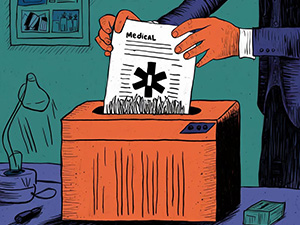
When 8.5 million Windows devices, including those at airlines, banks and hospitals, suddenly displayed the “Blue Screen of Death,” people began to panic. “We are under a cyber-attack!” most speculated. Fortunately, that was not the case, but the real reason behind the outage is alarming and something every business owner should be concerned about.
So, What Happened?
On July 19, 2024, millions of Windows devices crashed, triggering an endless reboot cycle and an unresolvable blue screen. This issue caused massive global disruptions. Airlines had to ground flights, leaving thousands of passengers stranded in airports and unable to book new routes home. Electronic health record software was knocked offline, forcing providers to cancel or delay nonemergency procedures, surgeries and medical visits. Several major banks also went offline, leaving customers unable to access their accounts. These were just some of the significant issues caused by what is now labeled the largest IT outage in history. Almost brings back those Y2K fears, doesn’t it?
If It Wasn’t A Cyber-Attack, What Caused It?
Many worried that the outage was due to a cybersecurity attack, but the source of the problem was a botched software update from CrowdStrike, a leading cybersecurity company. The team behind their endpoint detection and response (EDR) platform, Falcon, configured what should have been a routine sensor update. This update, specifically for Microsoft Windows, unknowingly had a flaw, and due to its tight integration with Windows OS, it resulted in widespread system crashes when it was pushed through.
How could a multibillion-dollar organization release an update with such a serious flaw? Representatives for the company later explained that it was due to a gap in their testing software. The issue stemmed from a flaw in the content validator tool, which failed to detect the problem in the update, leading engineers to believe everything was ready for release. As a result, the update forced Windows systems to enter an endless reboot cycle, displaying the infamous Blue Screen of Death.
As the situation unfolded, CrowdStrike immediately acted to fix the issue, but the damage was already done. Reports from insurers now estimate the outage will cost US Fortune 500 companies upward of $5.4 billion.
Why Should This Concern You?
This event reinforces how integrated technology is in our lives and underscores the significant impact a single software flaw can have on global IT infrastructure. When it comes to your company’s technology management, there is no substitute for having three things:
- A reliable, knowledgeable IT professional managing your network.
Accidents happen even in large organizations, as seen with CrowdStrike, but you can reduce your odds of being caught up in an issue like this by working with an experienced IT team. Their expertise and knowledge in updates, backups and constant awareness keep your operations running smoothly and prevent minor hiccups from escalating into full-blown disasters. - Rigorous software testing. If you have a reliable IT team, they should handle this for you.
- A robust disaster recovery plan. Mistakes will happen, and you need to be prepared to take action quickly so you can continue doing business and mitigate damage quickly. Many organizations affected by this outage had to pause business because they had no action plan for a disaster like this. Don’t be caught without plan B if something like this happens in your organization.
Don’t wait until you’re hit with a crisis to take action. Ensure your business is prepared by partnering with an experienced IT team. We offer a FREE, no-obligation Network Assessment where our team of experts will evaluate your current systems, identify potential vulnerabilities and develop a comprehensive plan to safeguard your business against future outages. Your company’s security and continuity depend on it.
Call us at 864-288-1114 or click here to book your FREE Network Assessment today!





